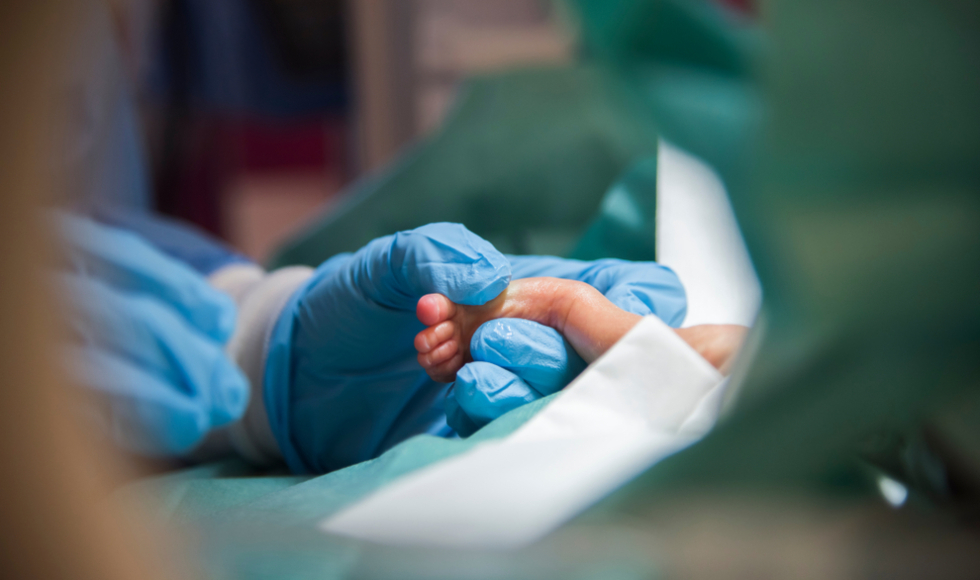Giving the breath of life to premature babies

Photo by MikoSokPhoto/Shutterstock
BY Sara Laux
June 22, 2018
The device looks a little like a drink coaster – a 9×9 cm square of translucent silicone rubber surrounding an embedded grid, with two tubes mounted on opposite corners.
That’s it – no whirring pumps. No power source. No flashing lights.
And yet a paper describing this simple device has just been highlighted as an Editor’s Pick in a recent issue of Biomicrofluidics – because it has the potential to one day make a life or death difference to a premature baby.
In the uterus, the placenta handles a baby’s need for oxygen, with the mother’s red blood cells providing oxygen directly to the baby’s blood. A baby’s lungs are the one of the last things to develop – which means that babies born prematurely can experience significant breathing trouble, called respiratory distress syndrome (RDS), as their lungs struggle to work in a way they’re not ready for.
To deal with RDS, pre-term babies are often mechanically ventilated. If that isn’t sufficient, life support is provided by an extra-corporeal membrane oxygenation (ECMO) machine, which, similar to a heart-lung bypass, pumps and oxygenates blood outside the body.
This keeps a preemie alive, but there are problems. Mechanical ventilation can damage the lungs and lead to severe long-term breathing complications, even into adulthood. ECMO is effective, but needs a high blood volume to work properly – and a typical one-kilogram pre-term baby has just seven tablespoons of blood in their body. And while using adult donor blood is possible, baby blood and adult blood is different, especially in the red blood cells’ ability to absorb oxygen. Also, ECMO is invasive, requiring surgery to access large blood vessels, and it requires a pump, which can damage blood cells and initiate clotting.
One solution to helping pre-term babies survive is to create a device that mimics what the placenta does, oxygenating a baby’s blood directly and eliminating the need for the underdeveloped lungs to work harder than they should.
And this is what biomedical engineering PhD student Mohammadhossein Dabaghi, professor Ravi Selvaganapathy and an international team of researchers are trying to do.
The team includes McMaster professor emeritus and former Jack Sinclair Chair in Pediatrics Christoph Fusch, who is currently the director of the department of pediatrics at Paracelsus Medical University in Nürnberg, Germany, as well as researchers from McMaster’s faculties of Health Sciences and Engineering.
The group has been working on an idea for an artificial placenta for the past six years – assessing the shortcomings of what’s currently available, refining the design and figuring out the fabrication techniques necessary to create something that will allow pre-term infants to breathe without using their lungs.
The result is a unique pumpless blood oxygenator, or lung assist device (LAD), that connects to the umbilical cord, rather than an artery or vein, and works with a baby’s heartbeat instead of an externally powered pump.
After the umbilical cord is cut, doctors connect it to the LAD instead of clamping it. When the heart beats, blood is sent through an intake tube through a grid of microchannels, which are sandwiched by membranes made from the same gas-permeable silicone as soft contact lenses. While in the microchannels, the blood exchanges its carbon dioxide for oxygen – and when the baby’s heart pumps again, the oxygenated blood is sent back into the body.
And while LAD looks like a floppy piece of silicone, it is super strong – thanks to a mesh made of stainless steel thinner in diameter than a human hair. It’s this mesh that makes the gas exchange from both sides of the device possible, while keeping the device reasonably thin.
“All good technology should be simple and intuitive to use – that’s what the artificial placenta is,” explains Selvaganapathy. “It requires very little change from what happens in nature. From the baby’s perspective, even though it’s pre-term, its heart is still pumping, and it’s still getting oxygen.”
The team has now demonstrated that the LAD has sufficient capacity to keep a pre-term baby oxygenated in an oxygen environment. They’re now working on conducting animal trials and refining the design so the device can simply work in ambient air, rather than needing extra oxygen.
“This was a nice milestone for us because we’ve demonstrated that we now have the capability to go on with more extensive animal trials and eventually human trials,” says Selvaganapathy, who is the Canada Research Chair in Biomicrofluidics. “From an engineering aspect, we now have the capability to provide sufficient oxygenation the way a placenta would.”


